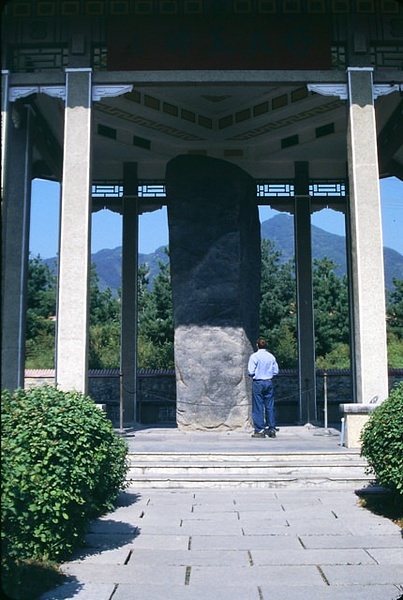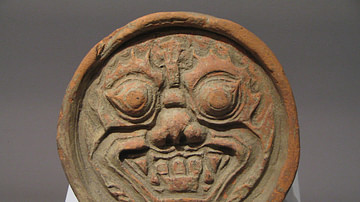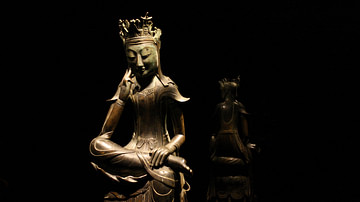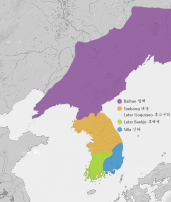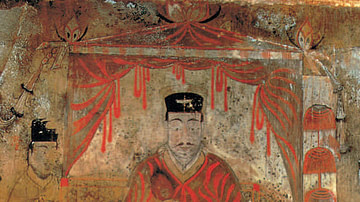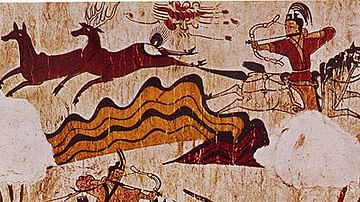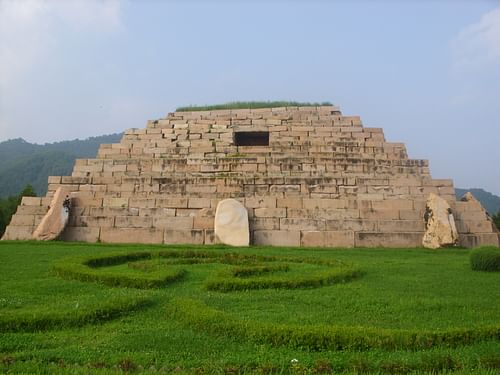
Gwanggaeto (Kwanggaeto), often referred to as Gwanggaeto the Great, was king of the Goguryeo (Koguryo) kingdom which ruled northern Korea during the Three Kingdoms period. Gwanggaeto reigned between 391 and 413 CE, and living up to his other title of 'broad expander of domain,' he extended the kingdom to its greatest extent and presided over the period of its greatest prosperity. His lasting reputation as one of Korea's finest leaders and field commanders is largely due to a lengthy inscribed stele set up outside his massive tomb at the then Goguryeo capital of Gungnae.
Goguryeo's Golden Period
The Goguryeo kingdom ruled from 37 BCE to 668 CE and was the largest of the Three kingdoms of ancient Korea. It was not until the 4th century CE that the state displayed a fully centralised government and control of its territory. Then the early 5th century CE saw the beginning of Goguryeo's greatest period during the reign of Gwanggaeto. A solid political foundation at home allied with pragmatic foreign relations with Goguryeo's neighbours Baekje (Paekche) and Silla went hand-in-hand with an aggressive expansionist policy towards northern tribes and the southern states of China. At the same time, friendly relations were maintained with China's northern states. The result of this mix of militarism and diplomacy was that Gwanggaeto was eventually able to dominate northern Korea, most of Manchuria, and a portion of Inner Mongolia. Goguryeo itself also benefitted from this prosperity with Gwanggaeto building nine new Buddhist temples at Pyongyang alone. So successful was this period that Gwanggaeto even coined a new term for it: Yongnak or 'Eternal Rejoicing.'
Gwanggaeto's Stele
Much of what is known of the history of this period derives from the 12th-century CE Samguk sagi text ('Historical Records of the Three States') and a 7.3 metre tall stele erected outside Gwanggaeto's tomb by his son Jangsu in 414 CE. The engraved stone recounts the king's exploits in 1,800 Chinese seal script characters. The stele is the earliest known inscription from ancient Korea and is an extraordinary historical record of the major events of Gwanggaeto's reign. The text begins by describing the foundation of Goguryeo by the legendary Go Jumong. There is then a quote from the Confucian classic text Shujing and a reference to the king by the Chinese reign title Yongnak. The latter is significant as it gives Gwanggaeto equal status to the Chinese emperor, who was the only other person permitted a reign title.
The text goes on to describe Gwanggaeto's accession to the throne when he was 19 years old, and then there is a long list of his military exploits. Reforming the armed forces of Goguryeo into separate naval, army, and cavalry units, the king assumed a position at the head of a centralised chain of command and led his men personally in the field. There were also developments at this time in metal forging so that Goguryeo warriors had superior steel weapons. With an armoured cavalry unit, he occupied the Liaodong fortress in south-eastern Manchuria, conquered the northern Murong, Sushen (Sukchin) and Yilou tribes, and captured areas of the rival Baekje kingdom to the south-west in 396 CE including briefly the capital Hansong, the Gwanmiseong fortress, and the strategically important Han River basin. The Baekje king Asin now took his orders from Gwanggaeto.
With Gwanggaeto's military support of 50,000 men, the Silla kingdom was able to successfully repel a Japanese Wa and Baekje invasion force in 400 CE. Indeed, the kingdom of Silla under the reign of Namul became a vassal of Goguryeo. Also in 400 CE Goguryeo and Silla again joined forces, this time to attack the small Gaya (Kaya) confederation in the far south of the peninsula. This alliance between Goguryeo and Silla may explain the presence of a lidded bronze bowl inscribed with Gwanggaeto's name which was discovered in a tomb at the Silla capital of Gyeongju. In effect, Goguryeo, albeit loosely, now controlled most of Korea.
In 406 CE a peace treaty was signed with the Murong Later Yan state in which Goguryeo was obliged to give military help against the Tuoba Northern Wei state of China in return for territorial gains. Near the end of his reign in 410 CE most of Manchuria and the neighbouring east coast area known as the Maritime Province of Russia were under Goguryeo control. The stele also states that the king conquered no fewer than 64 fortified towns and 1,400 villages so that when he died Goguryeo controlled two-thirds of the Korean peninsula and a large swathe of Manchuria.
The stele is not without some controversy. It disappeared for centuries only turning up again in the 1880s CE when, fortunately, a rubbing was taken of the text by a Japanese soldier. The portion of the stele text which describes Gwanggaeto's victory over the Japanese was vandalised during the Japanese occupation in the 20th century CE. Japanese historians maintain that the stele corroborates the theory that Japan had a colony in south-east Korea from 365 to 561 CE, but this is controversial.
Death & Tomb
Gwanggaeto died in 413 CE and was succeeded by his son Jangsu who, incredibly, reigned until 491 CE, earning him the deserved title of 'long-lived.' He continued his father's work, moved the capital from Gungnae to Pyongyang in 427 CE and ensured the continued prosperity of Goguryeo.
From the 4th century CE, Goguryeo kings were buried in tombs constructed of cut-stone blocks placed within large earth mounds. The largest example of such a tomb is at the former capital Gungnae and thought to be that of Gwanggaeto. It is also known as the Tomb of the General. 75 metres long and using blocks measuring up to 3 x 5 metres, it has four smaller dolmen-like structures at each corner. The stele which proclaims the great king's deeds stands just outside it.
This content was made possible with generous support from the British Korean Society.

